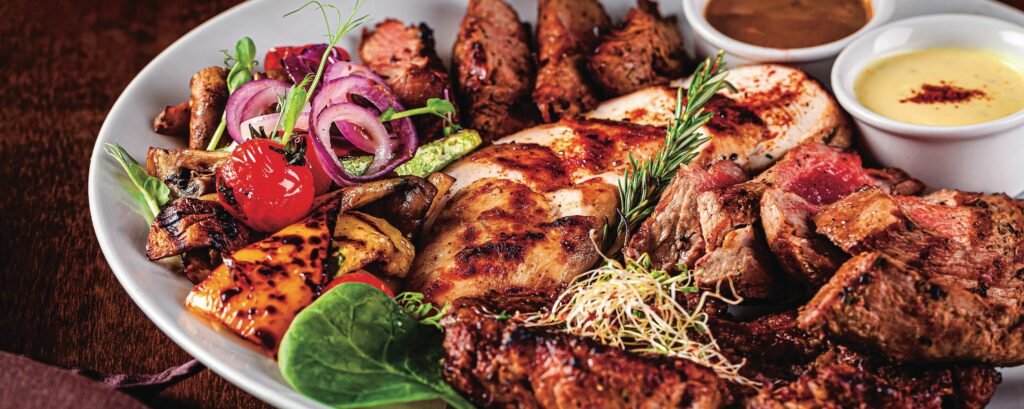Muslims need established standards to secure their right to halal food

Mohammad Abdullah
January/February 2022
A report by the International Market Analysis Research and Consulting Group (IMARC Group), valued the global halal market at $1.9 trillion in 2020 and expects it to grow at a CAGR (Compound Annual Growth Rate) of 11.3% during 2021-26. This is good news, but even better news would have been data showing a trend that Muslim corporations are overcoming decades of inertia and advancing toward self-sufficiency by owning and modernizing food-related industries to compete in the complex and competitive global food market.
Some Muslims are concerned that the lack of uniform halal standards enables global corporations to take advantage of the ensuing confusion among food producers and consumers. The race to produce cheap food products, complex food processing methods and fragmented, unregulated halal certification system used by food traders in the non-Organization of Islamic Cooperation (OIC) countries takes the essence out of the halal logo. Considering these factors, the report can only be described as winning the battle but losing the war.
Over 100 halal certification organizations exist worldwide. They have varied halal standards and no overall enforcement authority to establish uniform standards or hold a plant accountable when its products are determined to be contaminated with non-halal ingredients or to be falsely labelled as halal. Consumers wonder who is watching these global corporations to determine if their meat products are really halal or not.
According to Ab Talib et al., “most of the companies implement halal certification for the competition with their rivals, not for the motivation of the assurance of halal food authenticity. Therefore, a clear understanding of halal certification system is needed” (British Food Journal 117(11), Oct. 2015, 2664-2705).
Wael Hallaq states, “Globalization is a regulatory force that global institutions rely upon for further expansion of markets, both within its borders and outside them. There is no question that the balance of power has shifted and continues to shift in favour of the global market and away from the State” (“The Impossible State: Islam, Politics, and Modernity’s Moral Predicament,” Columbia University Press [2012], 142).
Globalization’s impacts are becoming evident on the smaller-scale halal meat industry, which cannot compete with the corporate conventional meat industry because large size translates into lower costs and greater efficiencies. So, whether willingly or not, the former has been slowly adopting the ways of the latter.
The 2011 UK Food Standards Agency figures note that 84% of cattle, 81% of sheep and 88% of chickens slaughtered for halal meat were stunned before they died. Supermarkets selling halal meat say they follow this practice. Tesco states that the only difference between its halal meat and other meat is that the animal was blessed as it was being killed (What is halal meat?, BBC NEWS, May 12, 2014).
According to a report, “the OIC/SMIIC [Standards and Metrology Institute for Islamic Countries (SMIIC)] has now published a 10-years plan that aims for uniformity in standardization, metrology, and accreditation activities. The OIC/SMIIC will promote its new standards and will help its member states in implementing them through training and so on” (“Explained: The Standards and Metrology Institute for Islamic Countries’ new ten-year plan, Aug. 2, 2021).
As the OIC/SMIIC promotes its new standards, it is worth mentioning that “In general, international halal standards claim to protect Muslim consumers, but if they are read carefully, it can be seen that these standards mainly aim to protect the interests of the industries producing food and non-food items for Muslims under the umbrella of halal” (Halal Certification and International Halal Standards, “The Halal Food Handbook,” 2020).
Several earlier attempts have been undertaken to harmonize existing standards; however, all of them have failed. The latest “strategic plan” was a five-year plan for 2016 to 2020. Given that the community has been unwilling to do anything about this, many Muslims have started to think of it as a secondary — or even an unresolvable — issue.
Halal certification organizations are allowing animals to be stunned prior to be slaughtered, on the grounds that it’s reversible. In other words, these animals stay alive. This looks good in theory, but in reality, it’s impractical to determine if this was the case in plants that slaughter about 400 or so cattle per hour, as well as 140-175 chickens per minute.
Stunning animals before slaughtering them is mandatory (9 C.F.R. 313.1 – 313.90, Food Safety and Inspection Service, Department of Agriculture). However, many countries have granted a “religious exemption” for those who slaughter animals according to the halal and shechita (kosher) methods. Lately, however, some countries have either already abolished this exemption or are in the process of doing so on the basis that it is cruel (Abdullah, “Religious Exemption is No Bar to Animal Welfare,” Islamic Horizons (pp.38-39), March/April 2018).
Today, this practice of stunning animals before slaughtering them is the “only leverage” the halal meat industry has leftover other kinds of meats. What halal-meat merchants, distributors and others affiliated with this industry would tell others why halal-meat is so special and why its demand continues to increase as the 2020 Global Halal Food Market Report asserts? [jw1]
There is no need to sweep these decades-old issues under the halal logo umbrella because sooner or later there will be new halal-related issues. – issues that we will have to face. As a society, Muslims are perfectly capable of deciding together how to address the challenges. However, this requires transparency, accountability in terms of developing and implementing the new standards, as well as explaining the entire process to the public in a clear and concise manner.
Dr Mohammad Abdullah, who retired after serving 29 years with the U.S. Department of Agriculture’s Food Safety and Inspection Service, the agency that regulates the meat industry, is the author of “A Closer Look at Halal Meat from Farm to Fork” (2016).